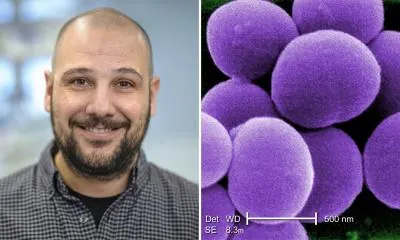
Unraveling Bacterial Defenses: A Revolutionary Strategy Against Antibiotic Resistance
2025-04-08
Author: John Tan
Imagine a world where deadly infections could be treated more effectively—scientists may have found the key. Researchers at Umeå University are exploring a groundbreaking approach involving the use of viruses that target bacteria, particularly the notorious Staphylococcus aureus, a common pathogen linked to severe conditions like septic shock and pneumonia.
As antibiotic resistance escalates globally, with certain subtypes of S. aureus showing multi-resistance, public health is under significant threat. Alarmingly, in some nations, up to 25% of S. aureus infections are resistant to treatment. In Sweden, the figure stands at a relatively low 1%, yet the potential for an outbreak remains a serious concern.
Enter bacteriophages, otherwise known as phages—viruses that specifically infect bacteria. These viral agents have been battling bacteria through an evolutionary arms race for eons. Bacteria develop defenses, and phages evolve new strategies to overcome these barriers. A crucial weapon in this trench warfare is the mobilome, a segment of the bacterial genome capable of transferring between strains and leading once-harmless bacteria to acquire dangerous traits.
In an intriguing twist, the Umeå research team has pinpointed specific genes within the S. aureus mobilome that grant immunity against phage infections. Utilizing state-of-the-art cryoelectron microscopy, they discovered that these genes code for proteins inhibiting phage replication. These proteins form a protective layer around key phage components, obstructing their ability to copy DNA and subsequently spread.
"This discovery not only sheds light on how resistant bacteria protect themselves against phages, but it also serves as a critical piece of the puzzle in combating antibiotic resistance," explains Ignacio Mir-Sanchis, Assistant Professor and lead author of the study. The implications are staggering: by targeting the mechanisms of these defenses, researchers might develop new therapies that could overturn the tide of antibiotic resistance.
As the battle against pathogens takes on new dimensions with such findings, the potential for innovative treatments grows. Understanding bacterial antiviral defenses may well pave the way for breakthrough strategies in how we manage and treat infections, making it a pivotal area of research for future public health initiatives.
Stay tuned as this groundbreaking research unfolds—it may be the turning point we desperately need in the fight against superbugs!

 Brasil (PT)
Brasil (PT)
 Canada (EN)
Canada (EN)
 Chile (ES)
Chile (ES)
 Česko (CS)
Česko (CS)
 대한민국 (KO)
대한민국 (KO)
 España (ES)
España (ES)
 France (FR)
France (FR)
 Hong Kong (EN)
Hong Kong (EN)
 Italia (IT)
Italia (IT)
 日本 (JA)
日本 (JA)
 Magyarország (HU)
Magyarország (HU)
 Norge (NO)
Norge (NO)
 Polska (PL)
Polska (PL)
 Schweiz (DE)
Schweiz (DE)
 Singapore (EN)
Singapore (EN)
 Sverige (SV)
Sverige (SV)
 Suomi (FI)
Suomi (FI)
 Türkiye (TR)
Türkiye (TR)
 الإمارات العربية المتحدة (AR)
الإمارات العربية المتحدة (AR)